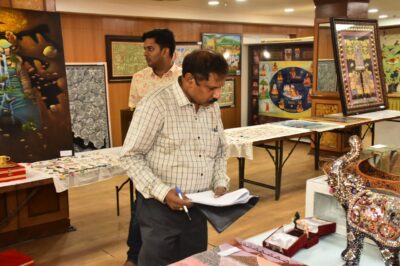
India, a land of diverse cultures and traditions, boasts a rich heritage of handicrafts that vary from region to region, each with its unique style and technique. Every province, district, and village in India has a cherished craft tradition. From the terracotta of Bankura and the intricate embroideries of West Bengal to the stone sculptures of Mamallapuram, Ellora, and Konark, and the world-famous bronzes of South India, these crafts are integral to the life rhythms of Indian people. The intricate cane and bamboo objects made in the Northeast further exemplify this collective ethos of India’s civilization, reflecting a commitment to excellence and a higher aesthetic sense that has marked artistic endeavors through the ages.
The Economic Relevance of Handicrafts
Handicrafts are not merely a connection to India’s glorious past but also a significant contributor to its economy. With over 6 million people practicing various crafts, this sector is crucial for rural employment and income generation. As agriculture becomes increasingly overburdened and the scope for employment in capital-intensive industries remains limited, the role of handicrafts in providing livelihood opportunities cannot be overstated. Recognizing this, the nation’s builders emphasized the importance of handicrafts even before independence, shaping a vision that continues to support these crafts.
Modern Challenges and Opportunities
Today’s global environment presents both challenges and opportunities for the handicrafts sector. There is a need for modernization and improvement in design, access to modern tools and technology, skill upgradation, and a sound marketing infrastructure. Providing high-quality inputs like yarn, dyes, and chemicals timely can significantly enhance the competitiveness of Indian crafts. Government policies must support sustainable growth in this sector, especially during testing economic times.
Handicrafts derive their value predominantly from human skill, making them unique and difficult to replicate by machines. This uniqueness is the key selling point of India’s exquisite handicrafts. To harness the artisans’ potential fully, efforts must be made to provide them with access to both domestic and international markets.
Recognizing Excellence in Handicrafts
Recognizing the extraordinary skills of artisans and designers who contribute significantly to the promotion, development, and preservation of craft traditions, the Northern Regional Office of the Development Commissioner (Handicrafts), Ministry of Textiles, Government of India, is organizing a high-level screening committee. This committee will select handcrafted products for further qualifying rounds in the selection of National Awardees, Shilp Gurus, and recipients of the Design Innovation and Startup Awards.
The committee, comprising renowned exporters, Directorate of Industries representatives, and Padma Shri awardees, will convene at Rajiv Gandhi Handicrafts Bhawan, New Delhi. The selected products will be presented to a central level committee comprising high-level government officials, senior designers, and previous award winners for the final selection.
The National Award: Honoring Craftsmanship
The primary goal of the National Award is to honor handicraft artisans for their contributions to the industry and inspire young artisans to continue their work with greater vigor. This award also aims to raise awareness of the use of cutting-edge technological innovations in the manufacture of handcrafted goods, highlighting the successes in terms of increased output.
The Screening Process
A total of 256 unique handcrafted products from the Northern Region (Rajasthan, Jammu & Kashmir, Himachal Pradesh, Delhi, Punjab, Haryana, Leh Ladakh) were received for this award selection. The artisans in this region showcased their skills, utility, fusion, science & technology, and concepts/themes through their products. The screening committee, under the supervision of Shri Virendra Kumar, Regional Director (Handicrafts), evaluated these products based on craft categories, product details, craft history, skill, and craftsmanship.
Conclusion
The best items were nominated for the National Award by the high-level screening committee, with the final selection meeting expected to take place soon. This initiative not only celebrates the rich tradition of Indian handicrafts but also ensures their preservation and growth in a modern, competitive market.








































Leave a Reply